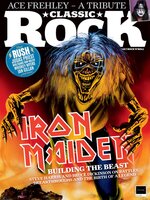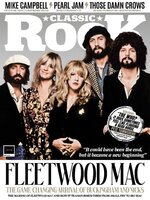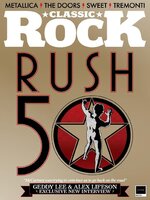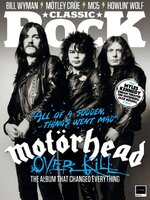Every month Classic Rock is packed with exclusive interviews and behind-the-scenes features on rock’s biggest names, from Led Zeppelin to Deep Purple, from Guns N’ Roses to the Rolling Stones, from the Sex Pistols to AC/DC and beyond. Each issue plays host to the heftiest rock reviews section on the planet. In an average issue, you’ll find over 150 albums reviewed, all from the ever-varied, multi-faceted world of rock - whether it’s hard rock or heavy metal, prog or punk, goth rock or southern rock, we’ve got it covered.
Editorial
CLASSIC ROCK
WATCH THAT MAN • Rock’n’roller, mod, mime artist, hippie – the young David Bowie tried everything in the search for fame before a sci-fi epic inspired his breakthrough hit. But even that would be a false start.
David Bowie • Intergalactic lullaby, break-up tune, moonshot tie-in, the five-minute, wildly inventive story song began Bowie’s fertile decade of ground-breaking pop.
THE MAN WHO SAW THE FUTURETHE MAN WHO SAW THE FUTURE • In 1970, David Bowie the one-hit wonder was on the brink of becoming David Bowie the decade-defining artist. The Man Who Sold The World was the album that helped him recalibrate his sound and vision.
THE BIRTH OF GLAM • The audience at 1970’s Atomic Sunrise Festival was largely indifferent to David Bowie’s new band, Hype, with their Lurex outfits and make-up. But one man wasn’t: Marc Bolan.
The Freakiest Show
David Bowie • How a young Bowie’s artistic manifesto was captured in three and a half perfect minutes.
LOVING THE ALIEN • By 1972, glam rock was kicking in but Bowie was still waiting for his big break. And then he hit on the character that would redefine him forever. This is an oral history of The Rise And Fall Of Ziggy Stardust And The Spiders From Mars.
ZIGGY IN AMERICA • Just under a year after Ziggy Stardust, Bowie released Aladdin Sane. His last album with the Spiders From Mars, it was a record written on the road, inspired by the USA and steeped in sex, drugs and ruthless ambition.
ZIGGY'S SUMMER HOLIDAY • After killing Ziggy and breaking up the band, David Bowie holed up in a French castle to record an album of fan-pleasing, critic-baiting 60s covers. This is the inside story of Pin Ups’ creation.
HIS BARK MATERIALS • Diamond Dogs was the point at which an unsettled David Bowie was shedding his glam-rock skin and shaping up to become the ‘plastic soul’ man of his next album. It was also, he said, “my most difficult album”.
Reborn In The USA • Glam rock was on its last legs when David Bowie fell hard for soul music, R&B and cocaine. The result was 1975’s Young Americans – the “plastic soul” masterpiece that put him on the map in the US.
David Bowie • Before his move to Berlin, Bowie got seriously funky on these two tracks, thanks to inspiration from Aretha Franklin, James Brown and his own 17-year-old mistress…
“We were both out of it, all the time” • He’s the guitar hero who connected a milk and cocainefuelled David Bowie with rock’n’roll during the Thin White Duke period. Earl Slick recalls the making of Station To Station, Bowie’s experimental masterpiece.
ACHTUNG BABY • Holed up in Germany with partner-incrime Iggy Pop, David Bowie released three albums between 1977 and 1979 that redefined him entirely – Low, “Heroes” and Lodger. This is the story of the Berlin Trilogy.
David Bowie “Heroes” • Although Bowie’s Berlin-period anthem was initially something of a commercial failure, it became his most life-changing single.
I've' never done anything out of the blue • After the minimalism of his ‘Berlin trilogy’, in 1980 David Bowie and his longtime producer Tony Visconti went all out for a kitchen-sink art-rock album. “We wanted to make our Sgt. Pepper!” The result: Scary Monsters.
FIIKRT...

 Jan 01 2026
Jan 01 2026
 Dec 01 2025
Dec 01 2025
 Nov 01 2025
Nov 01 2025
 Oct 01 2025
Oct 01 2025
 Sep 01 2025
Sep 01 2025
 Aug 01 2025
Aug 01 2025
 Summer 2025
Summer 2025
 Jul 01 2025
Jul 01 2025
 Jun 01 2025
Jun 01 2025
 May 01 2025
May 01 2025
 Apr 01 2025
Apr 01 2025
 Mar 01 2025
Mar 01 2025
 Feb 01 2025
Feb 01 2025
 Jan 01 2025
Jan 01 2025
 Dec 01 2024
Dec 01 2024
 Nov 01 2024
Nov 01 2024
 Oct 01 2024
Oct 01 2024
 Sep 01 2024
Sep 01 2024
 Aug 01 2024
Aug 01 2024
 Summer 2024
Summer 2024
 Jul 01 2024
Jul 01 2024
 Jun 01 2024
Jun 01 2024
 May 01 2024
May 01 2024
 Classic Rock Special: Bowie
Classic Rock Special: Bowie